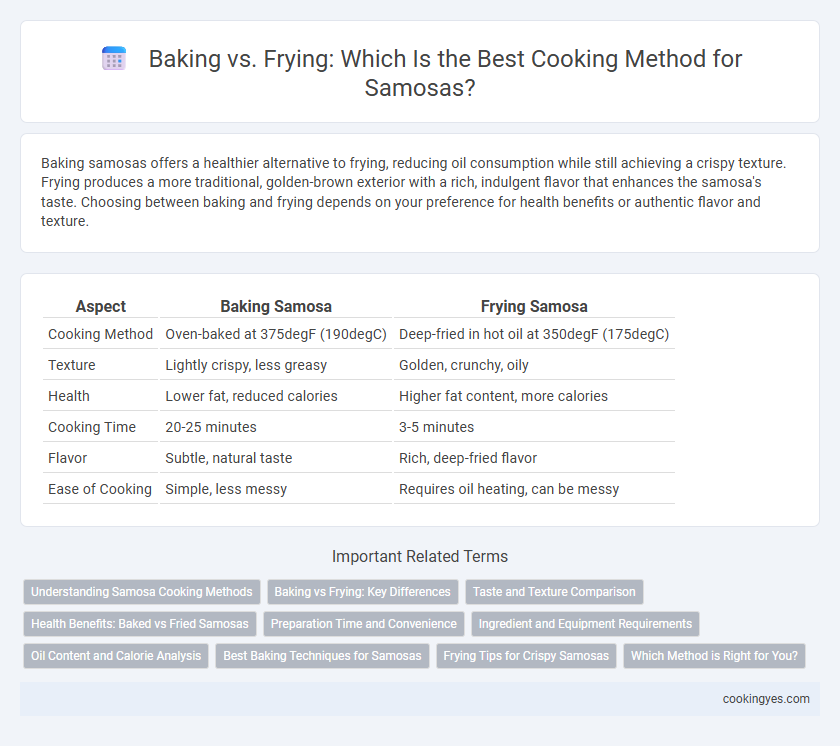Baking samosas offers a healthier alternative to frying, reducing oil consumption while still achieving a crispy texture. Frying produces a more traditional, golden-brown exterior with a rich, indulgent flavor that enhances the samosa's taste. Choosing between baking and frying depends on your preference for health benefits or authentic flavor and texture.
Table of Comparison
| Aspect | Baking Samosa | Frying Samosa |
|---|---|---|
| Cooking Method | Oven-baked at 375degF (190degC) | Deep-fried in hot oil at 350degF (175degC) |
| Texture | Lightly crispy, less greasy | Golden, crunchy, oily |
| Health | Lower fat, reduced calories | Higher fat content, more calories |
| Cooking Time | 20-25 minutes | 3-5 minutes |
| Flavor | Subtle, natural taste | Rich, deep-fried flavor |
| Ease of Cooking | Simple, less messy | Requires oil heating, can be messy |
Understanding Samosa Cooking Methods
Baking samosas offers a healthier alternative by reducing oil consumption while maintaining a crispy texture through high-temperature heat circulation. Frying samosas delivers a traditional golden-brown exterior with a rich, indulgent flavor due to deep oil immersion. Choosing between baking and frying depends on desired taste, texture, and nutritional preferences for authentic or health-conscious samosa preparation.
Baking vs Frying: Key Differences
Baking samosas results in a crisp exterior with less oil absorption, making them a healthier option compared to frying, which produces a golden, crunchy texture but increases calorie content due to deep oil immersion. Frying typically takes less time and provides a traditional taste and mouthfeel, while baking requires precise temperature control to achieve even browning without drying out the filling. The choice between baking and frying impacts the samosa's nutritional profile, texture, and overall flavor intensity.
Taste and Texture Comparison
Baking samosas results in a crisp, golden exterior with a lighter, less oily texture, enhancing the natural flavors of the filling without overpowering them. Frying produces a rich, crunchy crust with a slightly greasy finish, intensifying the savory taste and providing a traditional, indulgent mouthfeel. Taste preferences vary, but baked samosas appeal to health-conscious individuals seeking a balanced texture, while fried samosas satisfy those craving a classic, robust flavor and crunch.
Health Benefits: Baked vs Fried Samosas
Baked samosas contain significantly fewer calories and less oil compared to fried samosas, reducing the intake of unhealthy fats and lowering the risk of heart disease. Baking preserves the crisp texture while minimizing acrylamide formation, a potentially harmful substance produced in high-temperature frying. Choosing baked samosas over fried ones supports better digestion and weight management without compromising on flavor.
Preparation Time and Convenience
Baking samosas reduces preparation time by eliminating the need for oil heating and constant frying supervision, making the process more convenient and less messy. The baking method allows for batch cooking with minimal attention, suitable for busy kitchens or health-conscious individuals. In contrast, frying requires careful temperature control and monitoring, leading to longer preparation times and increased cleanup efforts.
Ingredient and Equipment Requirements
Baking samosas requires minimal oil and a preheated oven, along with a baking tray and parchment paper to ensure even cooking and a crisp texture, while using ingredients like whole wheat flour for a healthier, sturdier pastry shell. Frying demands more oil for deep immersion and a heavy-bottomed pan or deep fryer to maintain consistent heat, with the dough often made from refined flour for a lighter, flakier crust. Both methods call for fillings of spiced potatoes, peas, or meat, but baking is preferred for lower fat content and easier cleanup, whereas frying delivers a traditional, golden, and crunchier finish.
Oil Content and Calorie Analysis
Baking samosas significantly reduces oil content compared to frying, leading to lower calorie intake per serving. Fried samosas typically absorb more oil, resulting in higher fat content and increased calorie density. Opting for baked samosas can provide a healthier alternative without compromising the traditional crispiness.
Best Baking Techniques for Samosas
Baking samosas offers a healthier alternative to frying by reducing oil absorption while maintaining a crispy texture through high oven temperatures of 375-400degF and brushing the pastry with oil or butter. Using a convection oven ensures even heat distribution, resulting in golden and evenly cooked samosas without sogginess. Preheating the oven thoroughly and placing samosas on a perforated baking sheet helps moisture escape, preventing soggy bottoms and enhancing the overall crunch.
Frying Tips for Crispy Samosas
For perfectly crispy samosas, use hot oil heated to 350degF (175degC) to ensure even frying and prevent sogginess. Maintain this temperature throughout cooking by frying in small batches, allowing each side to turn golden brown and achieve a crunchy texture. Drain the samosas on paper towels immediately after frying to absorb excess oil and retain crispiness.
Which Method is Right for You?
Baking samosas offers a healthier alternative by reducing oil content while maintaining a crispy texture, ideal for those prioritizing low-fat diets. Frying samosas produces a classic golden-brown crust with richer flavor and a crunchier bite, preferred by traditionalists and those valuing authentic taste. Choosing between baking and frying depends on individual health goals, taste preferences, and time constraints.
Baking vs frying for samosa cooking method Infographic

 cookingyes.com
cookingyes.com